Zoom
Trash

Start Your Teaching Blog: Resources, Advice, and Examples. What's on your summer to-do list?
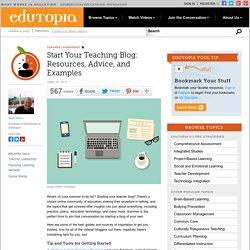
Starting your teacher blog? There's a vibrant online community of educators sharing their expertise in writing, and the topics that get covered offer insights into just about everything, including practice, policy, education technology, and many more. Summer is the perfect time to join that conversation by starting a blog of your own. Here are some of the best guides and sources of inspiration to get you started. And for all of the veteran bloggers out there, hopefully there's something here for you, too!
How and Why to Start Blogging in the Classroom. What does blogging in the classroom look like?
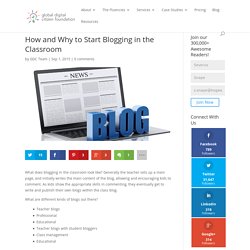
Generally the teacher sets up a main page, and initially writes the main content of the blog, allowing and encouraging kids to comment. As kids show the appropriate skills in commenting, they eventually get to write and publish their own blogs within the class blog. What are different kinds of blogs out there? Blogging in The Classroom: How to Get Started. It’s no secret that blogging is more than just a hobby.
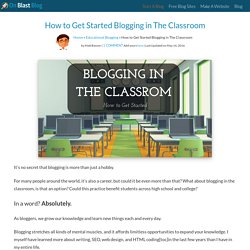
For many people around the world, it’s also a career, but could it be even more than that? What about blogging in the classroom, is that an option? Could this practice benefit students across high school and college? In a word? Absolutely. As bloggers, we grow our knowledge and learn new things each and every day. Blogging in the classroom: why your students should write online. Writing in classrooms seems to me to have two wildly different, conflicting purposes: a limited, traditional and strict purpose - because exams, like many decent jobs, will be about written skill; and a wider, idealistic one: the ultimate method of exchange of ideas in depth.

So, first, we should repeatedly use formal tests to acclimatise students to exam-specific writing requirements - dull, precise, necessarily regular. And beyond that, we'd let writing have free rein, encouraging students to be as ambitious, open-ended and wide-ranging as possible. That would mean loosening up most classroom time outside of the revise/test/peer-mark cycle to be about project work, self-directed learning, talk and flexibility; and we'd make the recording of learning a highly flexible process, for students to write what, and when, they like. So I've spent the past few months with GCSE and A-level classes doing absolutely no writing at all beyond sample tests and student blogs. Blogger in the Classroom. [Teacher's Insight] Best Ways to Use Blogging in the Classroom. Blogging in classroom - How to get started.
As education evolves and starts to embrace rapid developments in technology, we’re starting to see new teaching methods being introduced to the classroom that take advantage of this digital revolution.
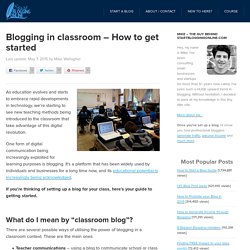
One form of digital communication being increasingly exploited for learning purposes is blogging. It’s a platform that has been widely used by individuals and businesses for a long time now, and its educational potential is increasingly being acknowledged. If you’re thinking of setting up a blog for your class, here’s your guide to getting started. So...You Wanna Use Blogs In The Classroom. Blogging is an important part of who I am as a professional.
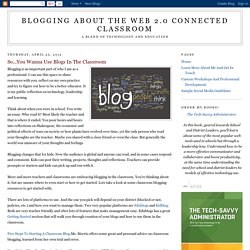
I can use this space to share resources with you, reflect on my own practice and try to figure out how to be a better educator. It is my public reflection on technology, leadership and learning. Think about when you were in school. You write an essay. Who read it? Blogging changes that for kids. Using Blogs to Integrate Technology in the Classroom, Education Up Close, Teaching Today, Glencoe Online. Using Blogs to Integrate Technology in the Classroom As the Internet becomes an increasingly pervasive and persistent influence in people's lives, the phenomenon of the blog stands out as a fine example of the way in which the Web enables individual participation in the marketplace of ideas.
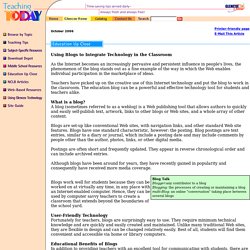
Teachers have picked up on the creative use of this Internet technology and put the blog to work in the classroom. 5 Reasons Why You Should Be Blogging In Your Classroom. Last fall, I decided to learn more about starting a blog in my classroom.

Thanks to an OLE contest, I had a brand new set of iPads. And with my new technology came an eagerness to try out all of the amazing things I had heard about it. Expanding the Uses of Blogs in the Classroom. The intersection of blogging and education is nothing new.
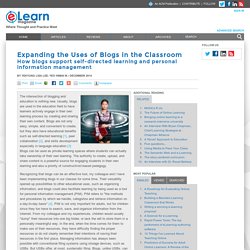
Usually, blogs are used in the education field to have learners actively engage in their own learning process by creating and sharing their own content. Blogs are not only easy, simple, and convenient to create, but they also have educational benefits such as self-directed learning [1], peer collaboration [2], and skills development especially in language education [3] Blogs can be used as private learning spaces where students can actually take ownership of their own learning. The authority to create, upload, and share content is a powerful source for engaging students in their own learning and also a priority of constructivist-based pedagogy. Recognizing that blogs can be an effective tool, my colleague and I have been implementing blogs in our classes for some time.
Studies on PIM suggest mental processes involved in PIM can facilitate learning. Education Week. Five Reasons to Try Student Blogs in your Classroom. Blogging in the 21st-Century Classroom. This year, I admitted a hard truth to myself.

I wasn't having my students write enough. The Benefits of Educational Blogging. This in an update of older posts about the benefits of educational blogging. 2013 is the sixth year that I have maintained a classroom blog. When I first began I didn’t know much about blogging at all and I didn’t realise there could be educational benefits to running a blogging program. I thought having a class blog would be a bit of fun and a good way to connect with parents.
As time has gone on I’ve come to realise that blogging brings many educational benefits. Years later I am still discovering new advantages for my students. The diagram below summarises the most powerful benefits I’ve found from blogging (so far): How to Blog With Young Students. Blogging -- or Web logging -- most often is thought of as an activity for high school students. How To Use Blogs In the Classroom. Blogs may be great educational tools and they give students complete freedom to publish content on the web, but if you don’t know how to effectively implement them into the classroom, they’re only as good as wadded up balls of paper in the trash. With the inception of Common Core standards and The No Child Left Behind Act, all educators require teaching literacy across the curriculum. Getting kids to write, especially the weaker writers, can be a challenge in itself but getting kids to write about math can be even more challenging – unless you use blogging as your literacy tactic.
Blog writing is informal, unlike academic writing, which may be intimidating to some, if not all, of your students. Ten Ways To Use Your Edublog – Click play for some great ideas! – Edublogs – free blogs for education. 1. Share materials, news, downloads, links and more Anything that you post to your blog will instantly be accessible by your students from school and from home. What’s more, you can easily manage who gets to access them through passwords and privacy measures. 2. Moderating and Ethics for the Classroom Instructional Blog. Moderating and Ethics for the Classroom Instructional Blog By Patricia Deubel02/26/07 ##AUTHORSPLIT## <---> 2/26/2007—If I still taught in K-12, would I use a blog? It's one of those new technology tools that some of us digital immigrants might struggle to appreciate. Knowing what I do now, I probably would at least try one because blogs can support the collaborative element so important for peer to peer learning.
EDU3484 Edu Blog Rubric. A Rubric for Evaluating Student Blogs. The pedagogical value and the challenges of integrating student blogging into your teaching is a recurring topic on ProfHacker. Some of our earliest posts dealt with student blogging, and we have revisited the issue frequently. Writing Lesson: Better Blogs. Subjects. Teaching With Blogs. Grades 9 – 12 | Lesson Plan | Standard Lesson. Handout Teacher Checklist for Blogging Projects.
Using Blogs in a History Classroom. What Is It? Handout Teacher Tips Blogging Projects. Top 50 Elementary Teacher Blogs. Check Out Class Blogs! Where's the Authentic Audience? Have you seen the "buzzword bingo" games that go around at conferences? According to Wikipedia, a buzzword has the characteristics of: Intentional vagueness. Their positive connotations prevents questioning of intent.